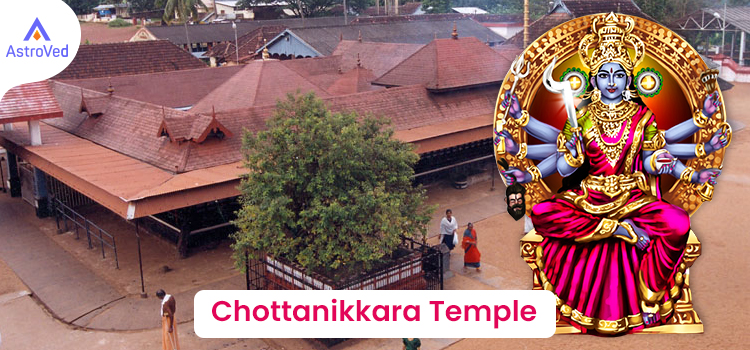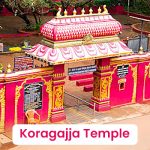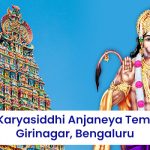Chottanikkara Devi Temple is a very famous temple dedicated to the Mother Goddess called Bhagavati. She is a form of Mahalakshmi. She, along with her husband, Maha Vishnu, supposedly reside in Chottanikkara, a southern neighborhood in the city of Kochi in Kerala.
This temple is the most important Temple among the 393 shrines spread over the 3 districts of Kerala and administered by the Cochin Devaswom Board. The temple is one of the 108 Abhimana Kshethrams of Vaishnavite tradition.
The Goddess here is also called Rajarajeswari, Mahalakshmi, Durga, Bhagavati, and Amman. There are separate temples for Ayyappa, Shiva, Ganapathi, Brahma, Hanuman, Yakshi, Brahmarakshassu, and the Nagas/snake gods in the temple complex.
Chottanikkara and Sabarimala temples are outstanding examples of the construction style featuring wooden sculptures of the old Vishwakarma Sthapathis. Sree Mahamaya Bhagavati is one of the most revered deities in Kerala.
At the temple, devotees worship the Goddess in three different forms. In the morning, she is Mahasaraswati, dressed in white; in the midday, she is Mahalakshmi, dressed in crimson; and in the evening, she is Mahakali, dressed in blue. Bhadrakali, a ferocious or Ugra form, is the goddess who is worshipped here as “Keezhkkaavu Bhagavathi.” Bhadrakali, a manifestation of mother Kali, supposedly appeared from Lord Shiva’s third eye to defeat the demon king Darika.
There is an idol of Mahavishnu on the same pedestal as the Bhagavathy, and so the Goddess is also called Ammenarayana, Devinarayana, Lakshminarayana, and Bhadrenarayana. Along with Lakshmi & Narayana, idols of Brahma, Siva, Ganapathi (Ganesh), Subramanya, and Sastha are on the same pedestal.
The temple is frequented by people who have mental problems, as Chottanikkara Devi is believed to heal such ailments. It is famous for its exorcism rituals. Late-night rituals take place here to invoke Mahakali. This is Guruthi Pooja and is usually performed only on Fridays.
Legends behind the Temple
The site where the temple stands was once a dense jungle that was the haunt of Raktharakshas (vampires) and Yakshis (female spirits who prey on young men). A tribesman and Kali devotee by the name of Kannappan lived here. He used to sacrifice a buffalo to Kali every Friday. Once, he saw a calf near the forest and abducted it. As he was about to sacrifice it, his daughter Pavizham intervened and begged him to spare its life. Unable to say No to her, he let her keep the calf as a pet. Sadly, Pavizham died some days later of snakebite.
Kannappan was distraught. But even worse was in store for him. When he tried to cremate Pavizham’s body, it vanished. A priest explained the reason for the bizarre incident. Kannappan would abduct young calves from the mother cows and sacrifice them. He incurred bad karma for these acts, and in retribution, his daughter passed away, and her body vanished. When he went in search of the calf, he discovered a shining altar in its place. The priest told him that the calf was divine and represented the deities Vishnu and Lakshmi. The priest told him to pray daily before the altar in order to receive absolution for his evil deeds.
After Kannappan died, the stone lay forgotten. One day, a low-caste grass cutter accidentally struck the stone and noticed that blood was dripping from it. She told the villagers about it. A local priest conducted a Devaprashnam and determined that the stone was divine. That day, the eldest Brahmin of the Yedattu household offered the Goddess some puffed rice in a coconut shell. This practice continues even today.
Another legend has associations with the spiritual teacher Shankaracharya. When Adi Shankara resided in Kerala, he found that there was no temple for the worship of Goddess Saraswati. So, he traveled to Kashmir and spent many days in meditation, hoping to see the Goddess there. Eventually, the Goddess, garbed in red, appeared before him. He told her his wish, which was to take her to Kerala and build a temple in her honor. Then, Keralites wouldn’t have to travel far to worship her. The Goddess agreed and said she would follow him wherever he went on foot, but only on one condition. He should not look behind him to see if she was following him. He agreed, and they began their journey, with Shankara leading the way. Hearing the tinkling sound of the Goddess’ anklets, he knew that she was right behind him. While descending the Kodachadri hills, the tinkling stopped suddenly. Shankara couldn’t resist stealing a backward glance. To his relief, he saw the goddess still standing there.
But suddenly, she disappeared, as Shankara had not kept his promise. This is the site where the Mookambika temple stands today. But Shankara was not one to give up easily. He begged the Goddess to accompany him to Kerala and apologized for violating her rule. Finally, the Goddess agreed to accompany him to Chottanikara, where the Chottanikara Devi temple eventually came up.
At the Chottanikkara temple, the Goddess gives darshan to her followers in the early morning hours. Then, she returns to the Mookambika temple in the afternoon. Since then, devotees have been worshipping Goddess Saraswati in front of the sanctum doors of the Chottanikkara temple by opening the main sanctum doors of the Mookambika temple first thing in the morning.
After the construction of the temple, the idol at Keezhkavu arrived. The story goes that a Yakshi once followed a Brahmin called Guptan Namboodiri, who was traveling through the forest to see his friend, Kosapilli Namboodiri, a practitioner of occult sciences. Yakshis take the form of beautiful women to trap young men and drink their blood.
Though Guptan was smitten by her, she was unable to harm him as he had a palm leaf replica of Devi Mahatmyam with him. When Guptan later told his friend about the experience, Kosapill immediately realized that the woman was a Yakshi. He handed Guptan Namboodiri a magical towel, some rice, and some instructions on how to carry it on his way back home in order to ward off the Yakshi. When the Yakshi began pursuing Guptan, he ran towards the Chottanikkara temple. Hearing his cries for help, the mother goddess Parvati appeared as Kali and killed the Yakshi. Then she threw her in the temple tank, which got the name Yakshikkulam or Rakthakulam.
Architecture of Chottanikkara Bhagavathy Temple
This temple complex is a good example of wooden architecture and sculpture. It is one of the biggest in Kerala.
The deity is Swayambu, or self-manifested. Hence the Devi’s idol here is in a ‘rock’ form with an irregular shape. It has a texture resembling Rudraksha. Hence, her image is called Rudraksha Sila. Now, a bronze plate, sculpted with the Goddess’ image, covers it. One can see a small black-colored stone deity (Shaligram) beside the Devi’s idol, which is supposedly a manifestation of Vishnu.
The idol of Bhagavathy is around four feet tall and is of red laterite. It faces the east direction. Her image is called Rudraksha Sila and has an irregular shape. One can see it only early in the morning when the sanctum opens for Nirmalyam.
The golden-hued idol in the main temple is adorned with colorful saris and fine jewelry. In her upper right hand is a disc; her upper left hand holds a conch, the lower right hand shows Varada mudra, and the lower left shows Abhaya Mudra. The conch and disc are Vishnu’s weapons.
Keezhkavu Bhagavathy, the Goddess in the form of the fierce Bhadrakali, is in a separate temple on the eastern side of the temple pond. Her idol was supposedly installed here by Vilvamangalam Swamiyar. Devotees believe that for the worship to be complete, they should pray at both the main temple of Goddess Bhagavathy and at the Keezhkavu temple.
The idol at Keezhkavu faces westward. After performing the Athazha Pooja (main pooja in the evening), the chief priest comes to Keezhkavu to perform the Valiya Guruthy Pooja (great sacrifice) at 8.45 pm every night. He prepares it in 12 cauldrons. The Guruthy Pooja is very awe-inspiring. It is a long ceremony and quite an experience. Being present during Valiya Guruthy on Fridays supposedly heals women suffering from mental abnormalities like schizophrenia forever. The bark of an ancient ‘Pala’ tree on the northeastern side of the sanctum sanctorum has many long iron nails on it. They have been hammered into the tree by possessed victims with their foreheads.
Festivals at the Temple
The main festival here is the yearly Chottanikkara Makam Thozhal. People who worship here during this significant Mithuna Lagna in Kumbham month can have wish fulfillment. Supposedly, Bhagavathy in her full attire appeared to Vilwamangalam Swamiyar on Makam day and also appears on the same day every year to give darshan to her devotees in her special appearance.
Thiruvonam festival is celebrated grandly in the temple with an Onasadya for all devotees in the month of Chingam.
In Kanni month, Navarathri Agosham also attracts huge crowds. Vidyarambham takes place on the day of Vijayadasami during the Navarathri utsavam.
In Vrishchikam month, there is the Vrishchikam Mandala Mahotsavam. Daily Annadanam, theater performances, Naama japam, etc., are some of the highlights. The Thrikkarthika event falls on this month. The celebration takes place during the three days of Kaarthika, Rohini, and Makayiram and celebrates the Goddess’ birthday. On these days, the celebrations include Deepaalankaaram, Ezhunnellippu, Kazhcha seeveli, stage acts, and fireworks. Lakshaarchana and Vedamura abishekam commence on January 1 for 15 days. Fireworks and Lakshadeepam attract crowds to the temple on Makaravilakku day.
In the month of Kumbam, the temple’s yearly festival takes place. Kodiyettu on Rohini star day, marks the beginning of the 9-day festival, which concludes on Uthram star day. Pooram Ezhunnellippu features 7 caparisoned elephants, both in the morning and at night. Uthram Aarattu and Valiya Guruthi mark the climax of the festival.
Benefits of Worshipping at the Temple
People come from far and wide seeking a cure for mental ailments and illnesses caused by demonic spirits. The priest talks to the patients for a while. Then, he ties a piece of the patient’s hair to the temple tree. This implies that the bad spirit has been confined in the tree, and the patient is free of their disease. Devotees take home neem leaves, limes, and chilies from the temple. These are believed to repel evil spirits.
How to Reach
Ernakulam Railway Station is 15 km from the temple.
Kochi Airport is 36 km from the temple.
Temple Timings
4 am – 12 pm and 4 pm – 9 pm


